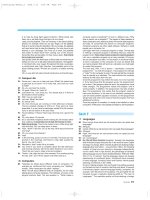Tài liệu Overview Of Degital Design With Verilog HDL part 3 docx
Bạn đang xem bản rút gọn của tài liệu. Xem và tải ngay bản đầy đủ của tài liệu tại đây (36.48 KB, 3 trang )
[ Team LiB ]
1.5 Popularity of Verilog HDL
Verilog HDL has evolved as a standard hardware description language. Verilog
HDL offers many useful features
• Verilog HDL is a general-purpose hardware description language that is
easy to learn and easy to use. It is similar in syntax to the C programming
language. Designers with C programming experience will find it easy to
learn Verilog HDL.
• Verilog HDL allows different levels of abstraction to be mixed in the same
model. Thus, a designer can define a hardware model in terms of switches,
gates, RTL, or behavioral code. Also, a designer needs to learn only one
language for stimulus and hierarchical design.
• Most popular logic synthesis tools support Verilog HDL. This makes it the
language of choice for designers.
• All fabrication vendors provide Verilog HDL libraries for postlogic
synthesis simulation. Thus, designing a chip in Verilog HDL allows the
widest choice of vendors.
• The Programming Language Interface (PLI) is a powerful feature that allows
the user to write custom C code to interact with the internal data structures
of Verilog. Designers can customize a Verilog HDL simulator to their needs
with the PLI.
[ Team LiB ]
[ Team LiB ]
1.6 Trends in HDLs
The speed and complexity of digital circuits have increased rapidly. Designers
have responded by designing at higher levels of abstraction. Designers have to
think only in terms of functionality. EDA tools take care of the implementation
details. With designer assistance, EDA tools have become sophisticated enough to
achieve a close-to-optimum implementation.
The most popular trend currently is to design in HDL at an RTL level, because
logic synthesis tools can create gate-level netlists from RTL level design.
Behavioral synthesis allowed engineers to design directly in terms of algorithms
and the behavior of the circuit, and then use EDA tools to do the translation and
optimization in each phase of the design. However, behavioral synthesis did not
gain widespread acceptance. Today, RTL design continues to be very popular.
Verilog HDL is also being constantly enhanced to meet the needs of new
verification methodologies.
Formal verification and assertion checking techniques have emerged. Formal
verification applies formal mathematical techniques to verify the correctness of
Verilog HDL descriptions and to establish equivalency between RTL and gate-
level netlists. However, the need to describe a design in Verilog HDL will not go
away. Assertion checkers allow checking to be embedded in the RTL code. This is
a convenient way to do checking in the most important parts of a design.
N
ew verification languages have also gained rapid acceptance. These languages
combine the parallelism and hardware constructs from HDLs with the object
oriented nature of C++. These languages also provide support for automatic
stimulus creation, checking, and coverage. However, these languages do not
replace Verilog HDL. They simply boost the productivity of the verification
p
rocess. Verilog HDL is still needed to describe the design.
For very high-speed and timing-critical circuits like microprocessors, the gate-level
netlist provided by logic synthesis tools is not optimal. In such cases, designers
often mix gate-level description directly into the RTL description to achieve
optimum results. This practice is opposite to the high-level design paradigm, yet it
is frequently used for high-speed designs because designers need to squeeze the
last bit of timing out of circuits, and EDA tools sometimes prove to be insufficient
to achieve the desired results.
Another technique that is used for system-level design is a mixed bottom-up
methodology where the designers use either existing Verilog HDL modules, basic
building blocks, or vendor-supplied core blocks to quickly bring up their system
simulation. This is done to reduce development costs and compress design
schedules. For example, consider a system that has a CPU, graphics chip, I/O chip,
and a system bus. The CPU designers would build the next-generation CPU
themselves at an RTL level, but they would use behavioral models for the graphics
chip and the I/O chip and would buy a vendor-supplied model for the system bus.
Thus, the system-level simulation for the CPU could be up and running very
quickly and long before the RTL descriptions for the graphics chip and the I/O
chip are completed.
[ Team LiB ]









